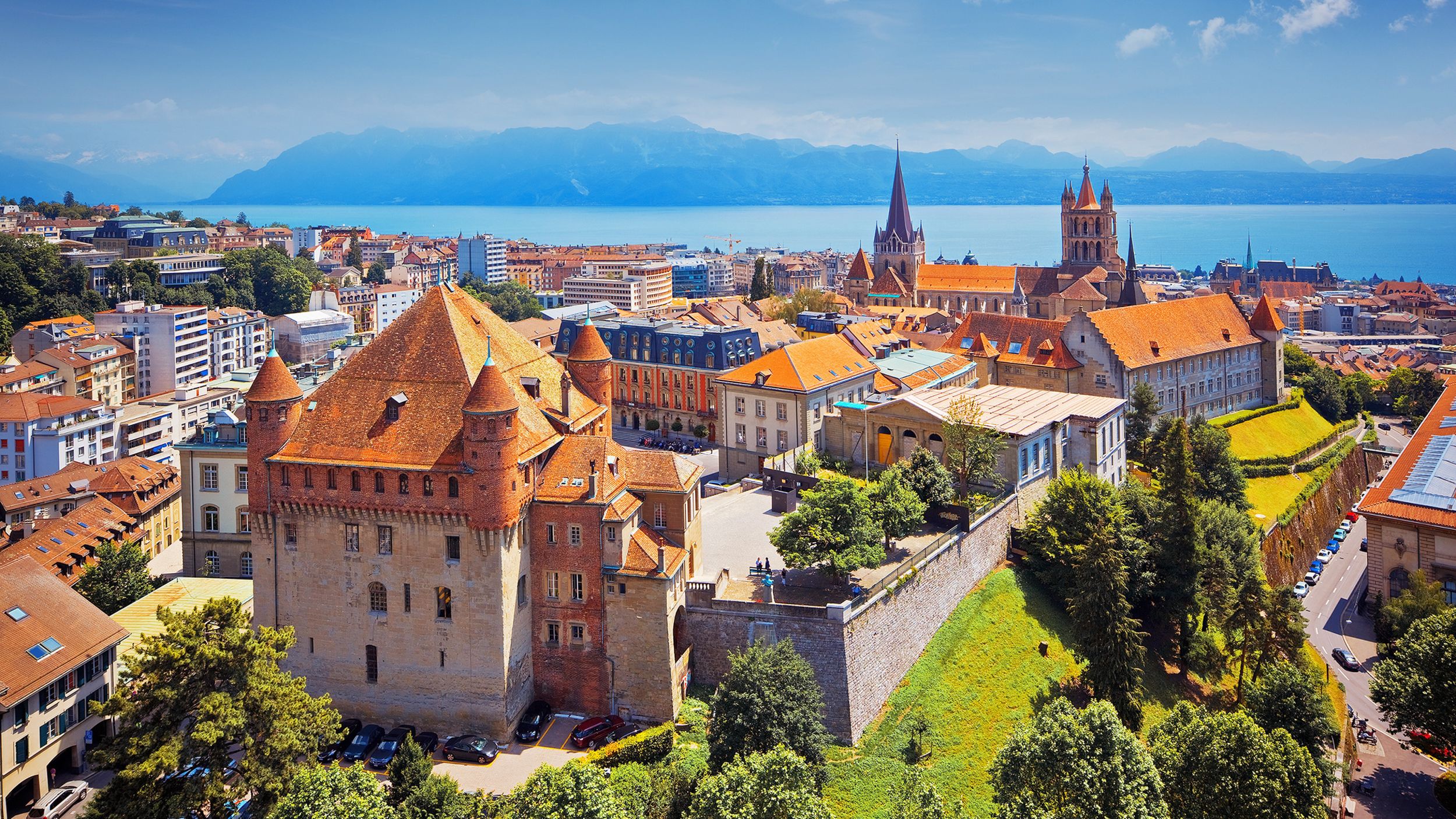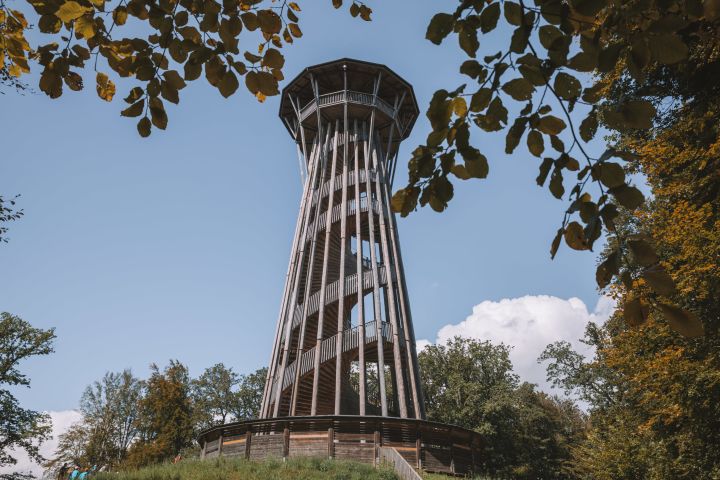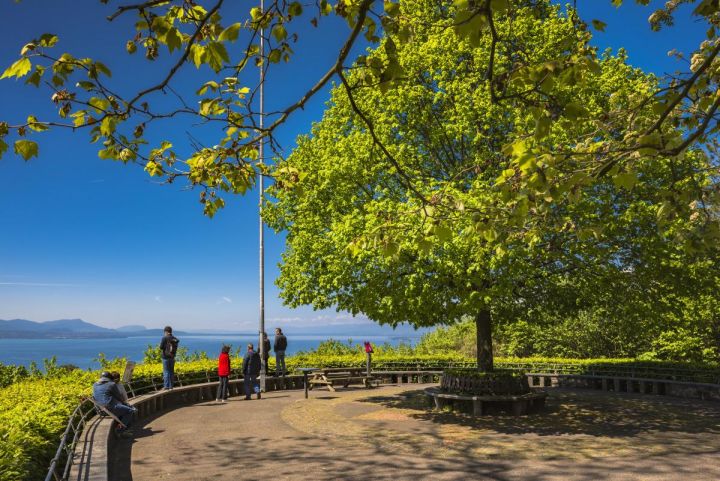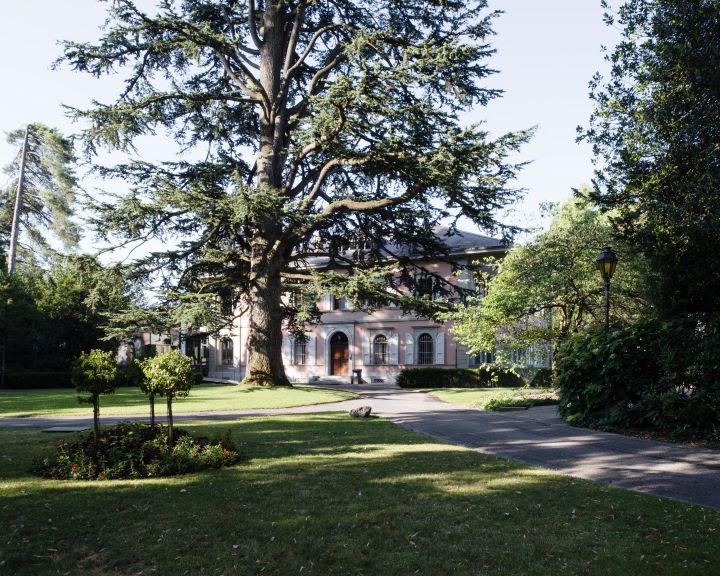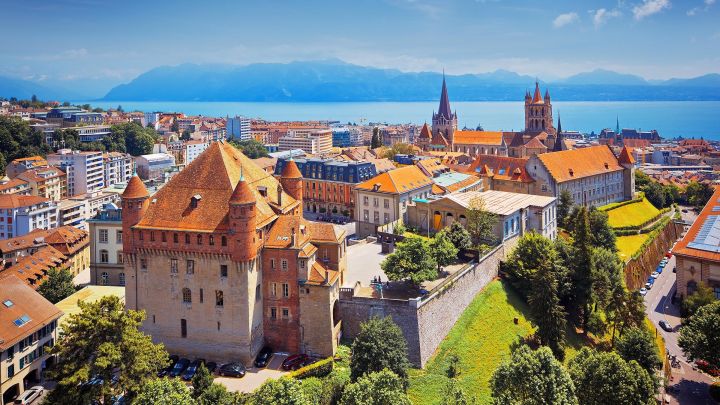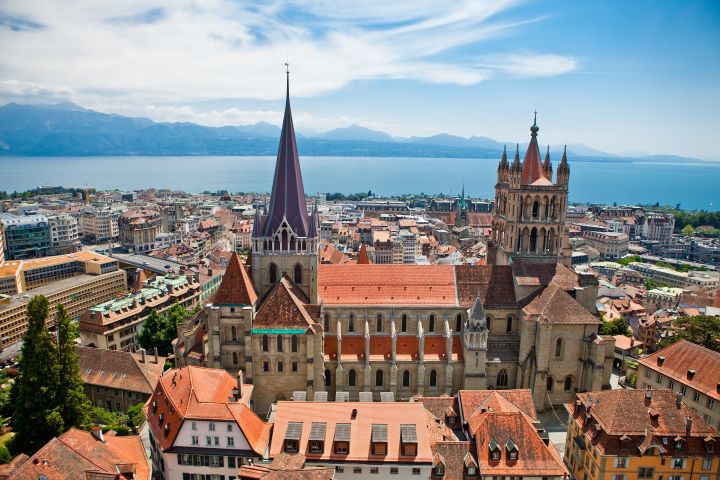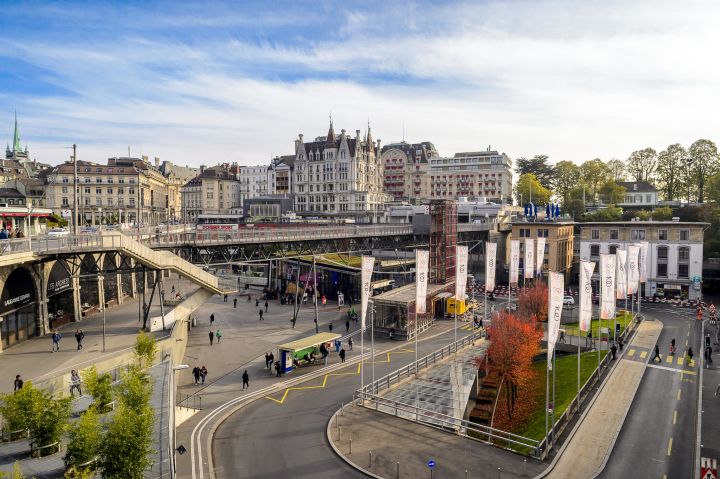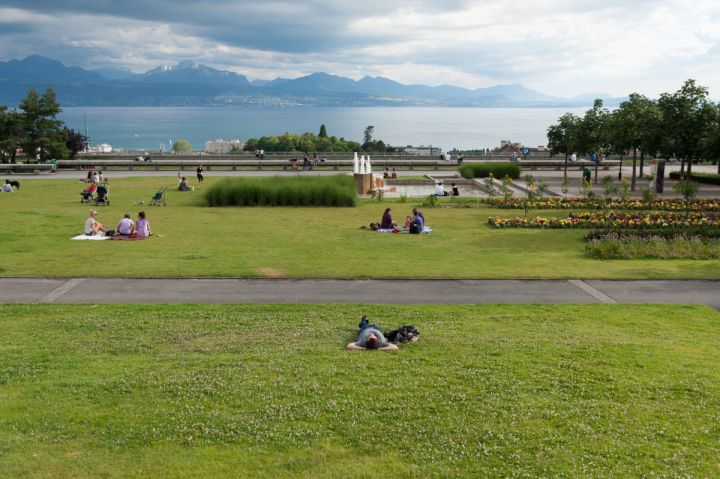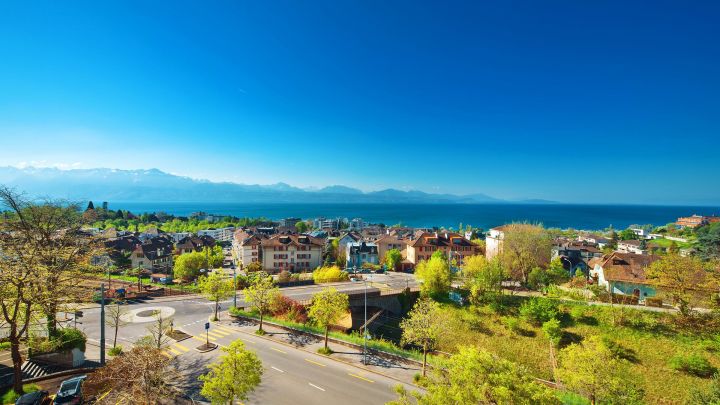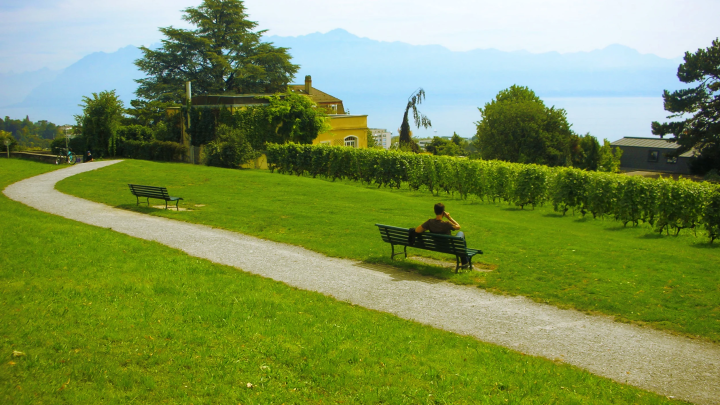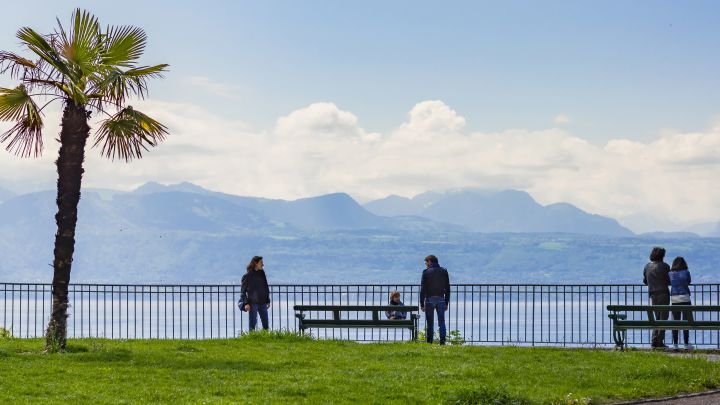360° views open up multiple vistas from the top of this 35-metre-high tower, which was built in 2003: you can view the Lausanne conurbation, Lake Geneva and the three geographic regions of Switzerland - the Alps, the Jura and the Plateau. This tower was built of wood, principally Douglas fir obtained from local forests. This is just one of many examples of how Lausanne is a city adept at sustainable development.
At the foot of the tower, you then continue along the wide tarred forest pathway. At the end of this pathway, turn left and go downhill to your right. At the bottom of the slope, cross the road at the pedestrian crossing next to a bus stop, then a little further along take the path that passes in front of a house with a pale orange façade. The end of this pathway brings you out at the Signal de Sauvabelin look-out post. 10 mins.
At the foot of the tower, you then continue along the wide tarred forest pathway. At the end of this pathway, turn left and go downhill to your right. At the bottom of the slope, cross the road at the pedestrian crossing next to a bus stop, then a little further along take the path that passes in front of a house with a pale orange façade. The end of this pathway brings you out at the Signal de Sauvabelin look-out post. 10 mins.
-
At the foot of the tower, you then continue along the wide tarred forest pathway. At the end of this pathway, turn left and go downhill to your right. At the bottom of the slope, cross the road at the pedestrian crossing next to a bus stop, then a little further along take the path that passes in front of a house with a pale orange façade. The end of this pathway brings you out at the Signal de Sauvabelin look-out post.
-
From the look-out post, take the only downhill path, then the one that descends immediately to your left. Lower down, near a large left-hand bend, make your way down to the left. Behind the trees, you will be able to make out a large meadow, with tall grass in the summer months. Head down across the meadow via a pretty grassy path that leads you to an orchard. Lower down, you soon find yourself at the “Fondation de l’Hermitage”, an art gallery housed in a historic mansion and a nearby outbuilding. Allow yourself some time in the English gardens on the lake side.
-
In this sublime park of understated elegance, there is a tree that is worth a visit all on its own. It is a weeping willow, situated some 50 metres south-west of the maison de maître, or manor house, that was planted when the park and outbuildings were laid out (1855-1857). Lying on the grass whilst contemplating the Savoy Alps and Lake Geneva, it's difficult to imagine that it's only a ten-minute walk to the town centre. With its majestic trees and its mansion, the park exudes a pleasant aura of calm and serenity.
-
To your right, a large arterial road heads into a hollow. It follows the initial course of the River Louve, which is now buried, but which over time hollowed out a valley in this spot. Together with its “cousin”, the Flon, this river created the Cité hillside by eroding the molasse, a grey rock used to build St. Maire Castle and the cathedral. Go from the castle courtyard to the cathedral.
-
Take the market stairs, which start opposite the main entrance to the Cathedral. At the very bottom of this stairway, make your way to Place de la Palud; you cross this square, passing in front of a fountain and then along past the city hall. Keep going straight ahead into this pedestrianised area. At first the street descends gently, but then it begins to climb. At the top, when you reach Place St-Laurent, turn left out of this square, taking Rue Pichard. Follow this street, which then heads right and takes you to a pedestrian footbridge.
-
As you make your way across the footbridge, the cathedral will appear like magic to your left, with the Grand-Pont Bridge in the foreground.Keep straight ahead, use the pedestrian crossing and then veer to your right. Keeping straight ahead, take the Allée Ansermet, a wide path the start of which is bordered by chestnut trees. This will take you to Esplanade de Montbenon and a statue of William Tell.
-
This site is one of the most beautiful balconies from which to view the lake. Here you will find a statue depicting a legendary Helvetian hero equipped with his crossbow: Guillaume Tell. In this ancient city centre square, just a stone's throw from the Church of St. Francis, Montbenon Esplanade offers you an extraordinary range of environments along a stretch of entirely flat ground covering more than half a kilometre, a novelty in Lausanne!
-
This site offers a further ample overview of the lakeand on the Alps, which becomes even more impressive the closer you approach. With such scenery, the name “Belvedere College” must have come as a natural and obvious choice for the college located on your right. At the bottom of Chemin des Croix-Rouges, take a right, then cross the bridge on your left that straddles the railway tracks. Then keep straight on, continuing along the Chemin du Languedoc path. After a few minutes and before a down slope, turn right to enter a small park planted with vines.
-
In the heart of the urban area, discover a unique vineyard. Finish by taking in the view from the hill in the botanical gardens. At the heart of the urban area, this council-owned vineyard is one of a kind. It reminds us that for many centuries the lower part of the city was thickly planted with vines. Retrace your steps as far as the start of the bridge, where you go downhill to your right via Chemin des Deux-Ponts. Cross the road at the pedestrian crossing and take the downhill path opposite, Chemin de Fontenay. Then turn left onto Chemin du Mont-Tendre, and right onto Chemin du Mollendruz. At the bottom of the latter, take a left. Just after the little church, go down to your right via the public footpath. At the bottom of this path, take the pedestrian walkway and this will bring you to a public park, Place de Milan. Climb to the top of the wooded hill adjoining the park in order to reach the final viewing point on this walk. There are several routes that allow you to do this, including one via the Botanical Gardens, which begin at the bottom of the park.
-
Formed by an ancient glacial moraine, this hill offers a unique panoramic vista over Lake Geneva, the mountains and the city. The Cantonal Botanical Museum and gardens, which include 6,000 plants from all over the globe, are situated on the southern hillside. The Place de Milan, a green space with a large grassy area, an ornamental lake and some ingenious children’s amusements, extends out from the base of the hill.




